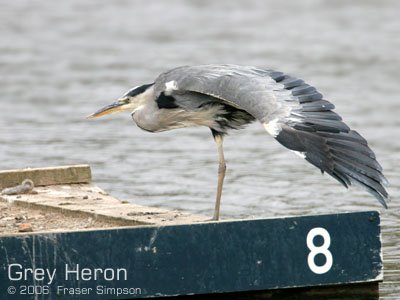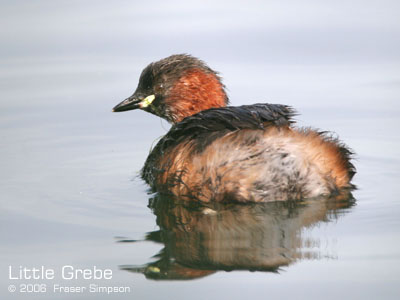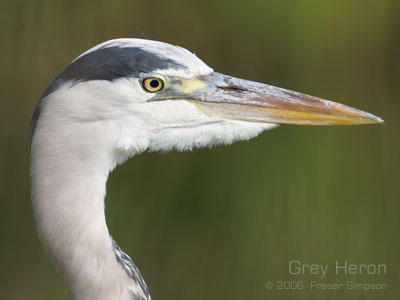
Monday, September 25, 2006
Terrifying Hitchcock Parrots
More dodgy environmental journalism this week, this time in The London Paper; one of the latest free evening papers distributed in the capital. In the Green London section, a story titled, Surrey under siege: Parrots make life intolerable for locals, claims that the Esher Rugby Club parakeet roost is terrorising locals in ‘scenes reminiscent of Alfred Hitchcock’s terrifying thriller The Birds’. Personally, I think the 7000+ flock must be the most impressive non-native wildlife spectacle in the British Isles. But then, my livelihood is not being threatened by them as some fruit farmers are claiming. These birds are Ring-necked (or Rose-ringed) Parakeets (Psittacula krameri) but the text does not even mention this and is accompanied by a random picture of a South American parrot (looks like a Conure sp.). Granted, there is the odd species with the Ring-necks but the writer could have researched the piece a bit more. Their natural distribution ranges across tropical Africa, through Asia to China – not Australia and South America as also claimed. An RSPB spokesman ended the piece saying: ‘…it is getting to the point where action will have to be taken’. I agree. Its time they installed a canopy tower to allow better views of them roosting in the poplar trees! Looks like they may be following the Ruddy Ducks…


Monday, September 18, 2006
Friday, September 15, 2006
Birds in the media this week
Apparently some birders list species seen on non-wildlife television programs. Maybe they should get out more. I don’t watch much TV but it is surprising how often birds appear on screen and are never mentioned, mainly because they are just there to provide a brief interlude or to set a scene. Spotted this week (yes, sadly by me):
Ring-billed Gulls in The Path to 9/11.
Alpine Choughs in some program I’ve forgotten with Peaches Geldof living in a cave in Morocco’s Atlas Mountains.
Smooth or Groove-billed Ani in El Salvador in Shock Docs: America’s Deadliest Gang.
Big news in the bird world this week is the publication of a paper detailing the discovery of a new species by a professional astronomer. My first thoughts were (a) what planet was this on?, and (b) maybe I’ve been using the wrong telescope all this time. Seriously though, a new species of babbler, named the Bugun Liocichla (Liocichla bugunorum) has been found by Ramana Athreya in the Eaglenest Wildlife Sanctuary, Arunachal Pradesh in northeast India. Remarkably, he first saw it way back in 1995 but was never recorded again until recently. The known population is thought to number just 14 individuals and is already threatened by a busy road proposal.
Read more on:
Birdlife International: Bugun Liocichla: a sensational discovery in northeast India
Discoveries of a different nature…. Closer to home, I received a news clipping from a local newspaper in Ayrshire about the “host of new wildlife species” turning up on Scottish Wildlife Trust reserves in the county. Sounded intriguing. Reading on I was bemused to hear about Scotch Argus at Knockshinnoch Lagoons and Dark Green Fritillary and Emerald Damselfly at Gailes Marshes, all apparently turning up for the first time. Has the SWT actually surveyed any of these places in the last 15 years? I’ve been seeing these species here for years and I’m sure a few of you reading this will have too. Don’t they even liaise with other conservation organisations such as Butterfly Conservation? If SWT don’t even know what species are on the land they are supposed to be managing, then what hope is there for the wider countryside in Ayrshire?
While I was at University. I remember writing to the SWT in Ayrshire with the hope of doing some voluntary conservation work. I received no reply. Eventually I phoned them and after acknowledging that they had received my letter I was met with a response along the lines of… “well…uhm, there’s not really much to do here”. This attitude would seem to a reveal a problem underlying the information in their press release.
Spotted in a ‘Reduced to clear’ bin in a bargain bookshop in Camden this week…. How to Survive Bird Flu by Anne Rooney.
For something completely different, visit my other blog: Luminous Nature.
Ring-billed Gulls in The Path to 9/11.
Alpine Choughs in some program I’ve forgotten with Peaches Geldof living in a cave in Morocco’s Atlas Mountains.
Smooth or Groove-billed Ani in El Salvador in Shock Docs: America’s Deadliest Gang.
Big news in the bird world this week is the publication of a paper detailing the discovery of a new species by a professional astronomer. My first thoughts were (a) what planet was this on?, and (b) maybe I’ve been using the wrong telescope all this time. Seriously though, a new species of babbler, named the Bugun Liocichla (Liocichla bugunorum) has been found by Ramana Athreya in the Eaglenest Wildlife Sanctuary, Arunachal Pradesh in northeast India. Remarkably, he first saw it way back in 1995 but was never recorded again until recently. The known population is thought to number just 14 individuals and is already threatened by a busy road proposal.
Read more on:
Birdlife International: Bugun Liocichla: a sensational discovery in northeast India
Discoveries of a different nature…. Closer to home, I received a news clipping from a local newspaper in Ayrshire about the “host of new wildlife species” turning up on Scottish Wildlife Trust reserves in the county. Sounded intriguing. Reading on I was bemused to hear about Scotch Argus at Knockshinnoch Lagoons and Dark Green Fritillary and Emerald Damselfly at Gailes Marshes, all apparently turning up for the first time. Has the SWT actually surveyed any of these places in the last 15 years? I’ve been seeing these species here for years and I’m sure a few of you reading this will have too. Don’t they even liaise with other conservation organisations such as Butterfly Conservation? If SWT don’t even know what species are on the land they are supposed to be managing, then what hope is there for the wider countryside in Ayrshire?
While I was at University. I remember writing to the SWT in Ayrshire with the hope of doing some voluntary conservation work. I received no reply. Eventually I phoned them and after acknowledging that they had received my letter I was met with a response along the lines of… “well…uhm, there’s not really much to do here”. This attitude would seem to a reveal a problem underlying the information in their press release.
Spotted in a ‘Reduced to clear’ bin in a bargain bookshop in Camden this week…. How to Survive Bird Flu by Anne Rooney.
For something completely different, visit my other blog: Luminous Nature.
Saturday, September 09, 2006
Cornmill Meadows & Fishers Green
Headed up to Cornmill Meadows Dragonfly Sanctuary in the Lee Valley for the Spotted Crake today. It had been showing from the Wake Hide for over week but seems to have departed now. Not surprising as the pond is almost completely dry as summer has reappeared again. Still, plenty of Migrant Hawkers and Ruddy Darters around as well as a few Clouded Yellows.


















Save the Albatross
The Save the Albatross campaign has had a lot of publicity this year and now the RSPB is extending this to The Tube under the Once extinct, you can only imagine campaign through posters and bluecasting tv commercials. I snapped this poster below on the Underground with the my mobile and is based on the question to school children of what they thought an albatross was… a bit like asking Londoners if they know what a decent service on the underground is… both of which could soon be rare and possibly extinct.
Most of the albatross species on the planet are at risk from longline fishing. You can sign the petition and find out more at: http://www.onceextinct.com/
Visit the RSPB/BirdLife Save the Albatross web site at www.savethealbatross.net

Most of the albatross species on the planet are at risk from longline fishing. You can sign the petition and find out more at: http://www.onceextinct.com/
Visit the RSPB/BirdLife Save the Albatross web site at www.savethealbatross.net

And here is another poster I grabbed with my mobile and doctored in photo editing software in response to my travelling experiences over the past few days on London Underground.

Friday, September 08, 2006
Saturday, September 02, 2006
Egret in the Docklands
Little Egrets are now fairly common in Southern England but I never tire of seeing them. They still hold some of that exotic, continental aura about them. This year saw the first breeding record for London. For the past few years a bird has regularly turned up in late summer in the docklands of East London at the Lea Valley nature reserve of East India Dock Basin. I took the Docklands Light Railway out there today to try and get some photographs but it was fairly wet and windy.












Subscribe to:
Comments (Atom)



















